Vermont Casting DVRT43, DVRT39, DVRT36 User Manual
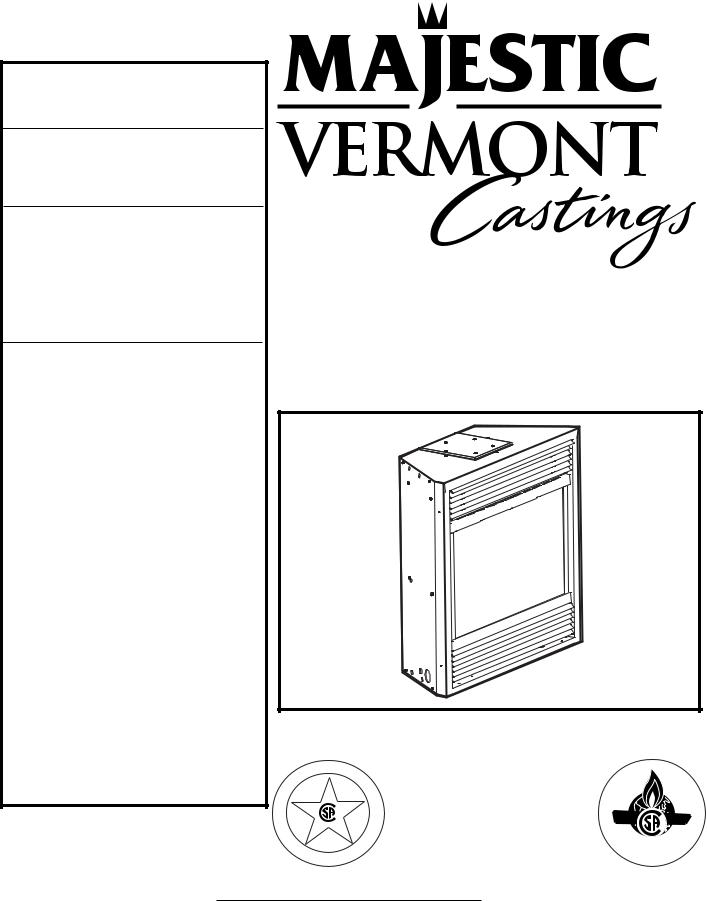
INSTALLER/CONSUMER SAFETY INFORMATION
PLEASE READ THIS MANUAL BEFORE INSTALLING AND USING APPLIANCE
WARNING!
IF THE INFORMATION IN THIS MANUAL IS NOT FOLLOWED EXACTLY, A FIRE OR EXPLOSION MAY RESULT CAUSING PROPERTY DAMAGE, PERSONAL INJURY OR LOSS OF LIFE.
FOR YOUR SAFETY Installation and service must be performed by a qualified installer, service agency or the gas supplier.
WHAT TO DO IF YOU SMELL GAS:
•Do not try to light any appliance.
•Do not touch any electric switch; do not use any phone in your building.
•Immediately call your gas supplier from your neighbor's phone. Follow the gas suppliers instructions.
•If you cannot reach your gas supplier call the fire department.
DO NOT STORE OR USE GASOLINE OR OTHER FLAMMABLE VAPORS AND LIQUIDS IN THE VICINITY OF THIS OR ANY OTHER APPLIANCE.
Direct Vent
Models: DVRT36
DVRT39
DVRT43
Homeowner's Installation &
|
S |
|
Operating Manual |
E IG |
N |
|
|
D |
|
|
|
CERTIFIED
C |
D |
E |
|
|
RTIFIE |
Vermont Castings, Majestic Products
410 Admiral Blvd. • Mississauga, Ontario, Canada L5T 2N6 • 905-670-7777 www.majesticproducts.com • www.vermontcastings.com
INSTALLER: DO NOT DISCARD THIS MANUAL - LEAVE FOR HOMEOWNER
10002428 11/03 Rev. 5

Vermont Castings, Majestic Products DVRT36/39/43
Table of Contents
PLEASE READ THE INSTALLATION & OPERATING INSTRUCTIONS BEFORE USING THE APPLIANCE.
Thank You and Congratulations on your purchase of a Vermont Castings, Majestic Products Fireplace. IMPORTANT: Read all instructions and warnings carefully before starting installation. Failure to follow these instructions may result in a possible fire hazard and will void the warranty.
Installation & Operating Instructions |
|
General Information .......................................................................................................................... |
3 |
Locating Your Fireplace .................................................................................................................... |
3 |
Fireplace Dimensions ....................................................................................................................... |
4 |
Clearance to Combustibles .............................................................................................................. |
6 |
Mantels ............................................................................................................................................ |
6 |
Hearth ............................................................................................................................................ |
6 |
Framing & Finishing .......................................................................................................................... |
7 |
Final Finishing ................................................................................................................................... |
7 |
Gas Specifications ............................................................................................................................ |
7 |
Gas Inlet and Manifold Pressures.................................................................................... .............. |
7 |
High Elevations ................................................................................................................................. |
7 |
Gas Line Installation ......................................................................................................................... |
8 |
Remote ON/ OFF Switch Installation ................................................................................................ |
8 |
Alternate Switch Location ................................................................................................................. |
8 |
EB-1 Electrical Box ........................................................................................................................... |
9 |
Electronic Gas Control Valve ............................................................................................................ |
9 |
Optional Top Vent Application ........................................................................................................ |
10 |
Installing the DVRT36RMH in a Mobile Home ............................................................................... |
10 |
Venting Installation Instructions |
|
General Venting .............................................................................................................................. |
11 |
General Venting Information -Termination Clearances ................................................................. |
12 |
General Information for Connecting Vent Pipes ............................................................................ |
13 |
Crimped End Pipes ......................................................................................................................... |
13 |
Twist-lock Pipes .............................................................................................................................. |
14 |
How to use the Vent Graph ............................................................................................................ |
14 |
Rear Wall Vent Application ............................................................................................................. |
14 |
Rear Wall Vent Installation ............................................................................................................. |
15 |
Vertical Sidewall Application .......................................................................................................... |
16 |
Vertical Sidewall Installation ........................................................................................................... |
17 |
Below Grade Installation ................................................................................................................. |
18 |
Vertical Through-the-Roof Application ........................................................................................... |
19 |
Vertical Through-the-Roof Installation ............................................................................................ |
20 |
Gravity Ducting System .................................................................................................................. |
21 |
Clearance to Combustibles ............................................................................................................ |
21 |
Venting Components, Twist-lock & Crimp End .............................................................................. |
23 |
Operating Instructions |
|
Glass Information ............................................................................................................................ |
25 |
Louvre Removal .............................................................................................................................. |
25 |
Window Frame Assembly Removal ............................................................................................... |
25 |
Glass Cleaning ................................................................................................................................ |
25 |
Installation of Logs & Lava Rock .................................................................................................... |
26 |
Flame & Temperature Adjustment ................................................................................................. |
27 |
Flame Characteristics ..................................................................................................................... |
27 |
Inspecting the Venting System ....................................................................................................... |
28 |
Lighting and Operating Instructions ............................................................................................... |
29 |
Instructions for RF Comfort Control Valve ..................................................................................... |
31 |
Auto Path Chart .............................................................................................................................. |
33 |
Comfort Valve System Control Sequence of Operation with Transmitter ..................................... |
34 |
Troubleshooting Guide ................................................................................................................... |
35 |
Fuel Conversion Instructions .......................................................................................................... |
38 |
Maintenance |
|
Cleaning the Standing Pilot Control System .................................................................................. |
39 |
Replacement Parts ....................................................................................................................................... |
40 |
Optional Accessories |
|
Fan Kits .......................................................................................................................................... |
43 |
Hard (Direct) Wire Hookup ............................................................................................................. |
43 |
Remote Controls. ............................................................................................................................ |
44 |
Ceramic Refractory Panels ............................................................................................................. |
44 |
Decorative Bay Window .................................................................................................................. |
44 |
Decorative Frame Trim ................................................................................................................... |
45 |
For Use in Mobile Homes: Model DVRT36MH ......................................................................................... |
46 |
Warranty ........................................................................................................................................................ |
48 |
Energuide ...................................................................................................................................................... |
50 |
2 |
10002428 |
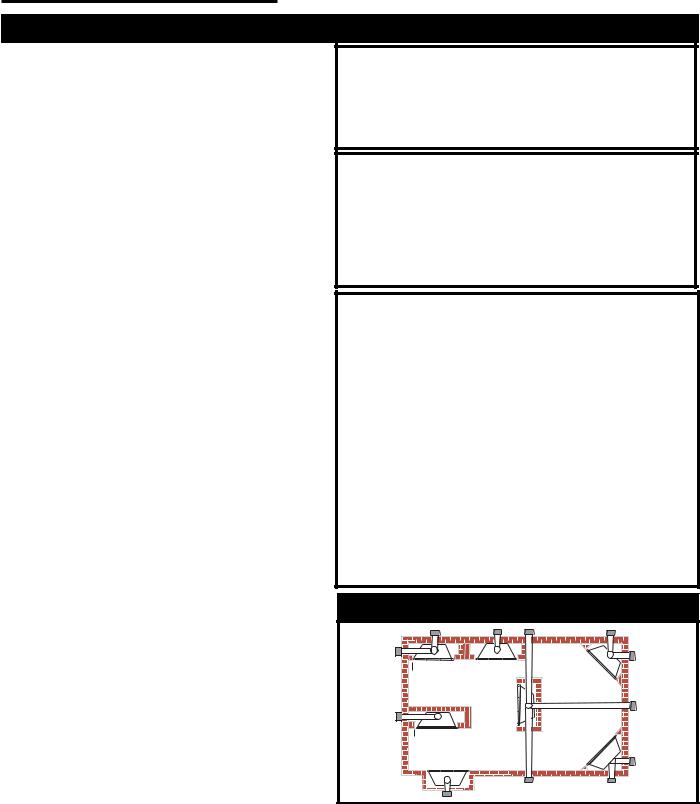
Vermont Castings, Majestic Products DVRT36/39/43
Installation & Operating Instructions
This gas appliance should be installed by a qualified installer in accordance with local building codes and with current CSA-B149.1 Installation codes for Gas Burning Appliances and Equipment. If the unit is being installed in a mobile home, the installation should comply with the current CAN/ CSA Z240.4 code. For U.S.A. Installations follow local codes and/ or the current National Fuel Gas Code, ANSI Z223.1/NFPA 54.
FOR SAFE INSTALLATION AND OPERATION, NOTE THE FOLLOWING:
1.This fireplace gives off high temperatures and should be located out of high traffic areas and away from furniture and draperies.
2.Children and adults should be alerted to the hazards of the high surface temperatures of this fireplace and should stay away to avoid burns or ignition of clothing.
3.Children should be carefully supervised when in the same room as your fireplace.
4.Under no circumstances should this fireplace be modified. Parts removed for servicing should be replaced prior to operating this fireplace again.
5.Installation and any repairs to this fireplace must be performed by a qualified installer, service agency or gas supplier. A professional service person should be contacted to inspect this fireplace annually. Make it a practice to have all of your gas fireplaces checked annually. More frequent cleaning may be required due to excess lint and dust from carpeting, bedding material, etc.
6.Control compartments, burners and air passages in this fireplace should be kept clean and free of dust and lint. Make sure the gas valve and pilot light are turned off before you attempt to clean this fireplace.
7.The venting system (chimney) of this fireplace should be checked at least once a year and if needed your venting system should be cleaned.
8.Keep the area around your fireplace clear of combustible materials, gasoline and other flammable vapor and liquids. This fireplace should not be used as a drying rack for clothing, nor should Christmas stockings or decorations be hung in the area of it.
9.Under no circumstances should any solid fuels (wood, coal, paper or cardboard etc.) be used in this fireplace.
10.The flow of combustion and ventilation air must not be obstructed in any way.
11.When fireplace is installed directly on carpeting, vinyl tile or any combustible material other than wood, this fireplace must be installed on a metal or wood panel extending the full width and depth of the fireplace.
12.This fireplace requires adequate ventilation and combustion air to operate properly.
13.This fireplace must not be connected to a chimney flue serving a separate solid fuel burning fireplace.
14.When the fireplace is not in use it is recommended that the gas valve be left in the “OFF” position.
Proposition 65 Warning: Fuels used in gas, woodburning or oil fired appliances, and the products of combustion of such fuels, contain chemicals known to the State of California to cause cancer, birth defects and other reproductive harm.
California Health & Safety Code Sec. 25249.6
This appliance may be installed in an aftermarket permanently located, manufactured home or mobile home, where not prohibited by local codes.
This appliance is only for use with the type of gas indicated on the rating plate. This appliance is not convertible for use with other gases, unless a certified kit is used.
The DVRT36RMH has been approved for mobile home installations.
IMPORTANT:
PLEASE REVIEW THE FOLLOWING CAREFULLY
Remove any plastic from trim parts before turning the fireplace “ON”.
It is normal for fireplaces fabricated of steel to give off some expansion and/or contraction noises during the start up or cool down cycle. Similar noises are found with your furnace heat exchanger or car engine.
It is not unusual for your Vermont Castings, Majestic Products gas fireplace to give off some odor the first time it is burned. This is due to the curing of the paint and any undetected oil from the manufacturing process.
Please ensure that your room is well ventilated - open all windows.
It is recommended that you burn your fireplace for at least ten (10) hours the first time you use it. If the optional fan kit has been installed, place the fan switch in the “OFF” position during this time.
Locating the Fireplace
E |
A |
B |
Y |
|
|
|
|
|
|
|
X |
|
|
C |
D |
|
|
Y |
|
B |
|
|
|
|
F |
|
LU584-1
Fig. 1 Locating the Gas Fireplace.
A) Flat on wall |
B) Cross corner |
C) Island** |
D) Room divider*/ ** |
E) Flat on wall corner* |
F) Chase installation |
Notes (Fig. 1): |
|
Y) 6 in. minimum |
*When you install your Vermont Castings, Majestic Products fireplace in
(D) Room divider or (E) Flat on wall corner positions, a minimum of (Y), 6 in. (153 mm) clearance must be maintained from the perpendicular
wall and the front of the fireplace.
**Island (C) and Room Divider (D) installation is possible if the horizontal portion of the vent system (X) does not exceed 20 ft. (610 cm). See details in Venting Section.
10002428 |
3 |
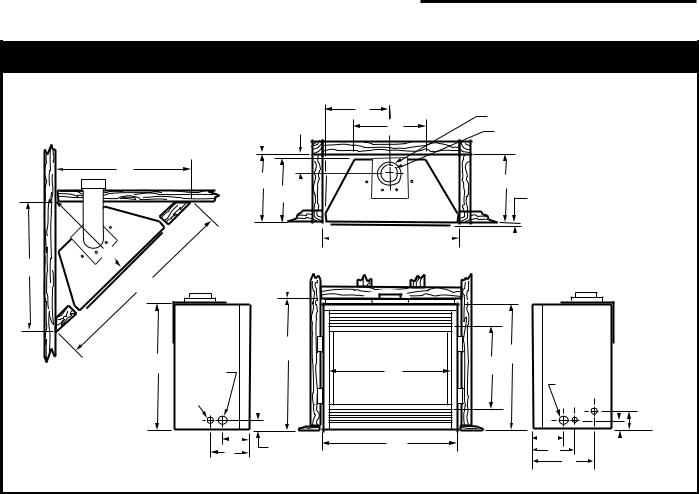
Vermont Castings, Majestic Products DVRT36/39/43
|
|
Fireplace Dimensions (Installed as Top Vent) |
|
|
||||||
|
|
|
|
|
|
C |
|
|
|
|
|
|
|
|
|
|
L |
|
|
|
|
|
|
|
|
|
5¹⁄" |
L |
7" Dia. (178mm) |
|
||
|
|
Rough |
F |
|
||||||
|
|
(140mm) |
|
4" Dia. (102mm) |
|
|||||
|
|
Opening |
|
|
||||||
|
|
|
|
|
|
|
|
|||
|
|
Depth |
|
|
|
|
|
|
||
|
M |
|
|
O |
|
|
|
O |
|
|
|
|
|
|
G |
|
|
Recessed |
|
||
|
|
|
|
|
|
|
|
|
||
|
|
|
|
|
|
|
|
Nailing |
|
|
|
|
|
|
|
|
|
|
|
Flange |
|
|
|
|
|
|
|
P - Rough Opening Width |
|
5/8" (16mm) |
|
|
M |
R |
|
|
Rough |
|
|
|
|
|
|
|
|
|
|
|
|
|
|
|||
|
N |
|
|
Opening |
|
|
|
|
|
|
|
|
|
Height |
|
|
|
|
|
||
|
|
|
|
|
|
|
|
|
||
|
C |
|
|
|
Q |
|
|
C |
|
|
|
Gas Line |
|
|
|
|
D |
|
|
||
|
|
|
|
E |
|
|
|
|||
|
|
Access |
|
|
|
|
Gas Line |
|
||
|
|
|
|
|
|
|
|
|||
|
|
Electrical |
|
|
|
|
|
|
Access |
|
|
|
|
|
|
|
|
|
|
|
|
|
|
Access |
|
|
|
|
|
|
|
|
|
|
|
|
|
|
|
|
|
|
4" (102mm) |
|
|
|
I |
|
2" |
A |
|
|
I |
2" (51mm) |
|
|
J |
|
|
|
|
J |
|||
|
|
|
(51mm) |
|
|
|
|
|||
|
|
|
|
|
|
|
|
|
K |
|
|
|
|
|
|
|
|
|
|
|
CFM188 |
Fig. 2 |
Fireplace specifications and framing dimensions. |
|
|
|
|
|
||||
Ref. |
DVRT36 |
DVRT39 |
DVRT43 |
|||
A |
36” |
(914mm) |
39” |
(991mm) |
43” |
(1092mm) |
B |
37¹⁄ ” |
(946mm) |
37¹⁄ ” |
(946mm) |
40” |
(1016mm) |
C |
34¹⁄ ” |
(870mm) |
34¹⁄ ” |
(870mm) |
37” |
(940mm) |
D |
21” |
(533mm) |
21” |
(533mm) |
23 ¹⁄ ” |
(597mm) |
E |
32 ⁄ ” |
(835mm) |
35 ⁄ ” |
(911mm) |
39 ⁄ ” (1012mm) |
|
F |
20” |
(508mm) |
24 ³⁄ ” |
(619mm) |
31” |
(787mm) |
G |
14¹⁄ ” |
(362mm) |
15³⁄ ” |
(400mm) |
16¹⁄ ” |
(412mm) |
H |
6” |
(152mm) |
6” |
(152mm) |
6” |
(152mm) |
I |
5¹⁄ ” |
(140mm) |
5¹⁄ ” |
(140mm) |
5¹⁄ ” |
(140mm) |
J |
7³⁄ ” |
(197mm) |
8¹⁄ ” |
(216mm) |
8¹⁄ ” |
(216mm) |
K |
10³⁄ ” |
(273mm) |
12¹⁄ ” |
(318mm) |
12¹⁄ ” |
(318mm) |
L |
18” |
(457mm) |
19¹⁄ ” |
(495mm) |
21¹⁄ ” |
(546mm) |
|
|
|
Framing Dimensions |
|
|
|
M |
36” |
(914mm) |
40” |
(1016mm) |
44” |
(1118mm) |
N |
51” |
(1295mm) |
56” |
(1422mm) |
62 ¹⁄ ” (1581mm) |
|
O |
14¹⁄ ” |
(368mm) |
16¹⁄ ” |
(419mm) |
16¹⁄ ” |
(419mm) |
P |
36¹⁄ ” |
(927mm) |
39¹⁄ ” (1003mm) |
43¹⁄ ” (1105mm) |
||
Q |
35” |
(889mm) |
35” |
(889mm) |
37 ³⁄ ” |
(959mm) |
R |
25¹⁄ ” |
(648mm) |
28” |
(711mm) |
36¹⁄ ” |
(918mm) |
|
|
|
|
|
|
|
4 |
10002428 |
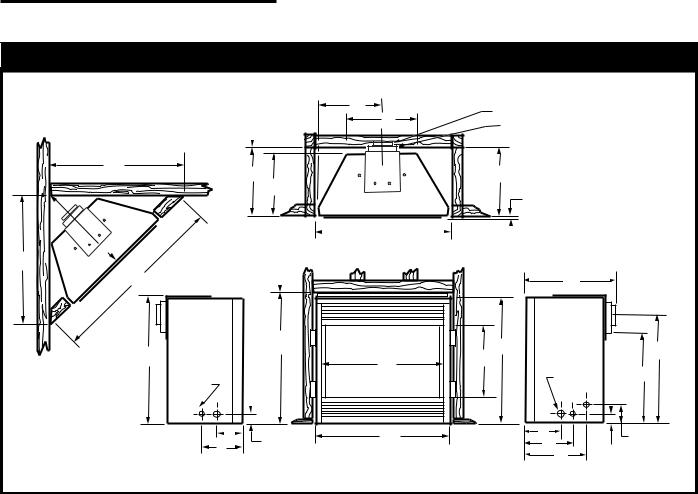
Vermont Castings, Majestic Products DVRT36/39/43
Fireplace Dimensions (Installed as Rear Vent)
|
|
|
C |
|
|
|
|
|
L |
|
|
|
|
|
M |
4" Dia. (102mm) |
|
|
Rough |
E |
|
||
|
7" Dia. (178mm) |
|
|||
|
Opening |
|
|
||
|
|
|
|
||
|
Depth |
|
|
|
|
|
O |
P |
|
P |
|
|
|
|
|
||
|
|
F |
|
Recessed |
|
|
|
|
|
Nailing |
|
|
|
|
|
Flange |
|
|
|
|
Q - Rough Opening Width |
5/8" (16mm) |
|
|
|
|
|
|
|
O |
S |
Rough |
|
|
|
|
|
|
|
||
|
N |
Opening |
|
G |
|
|
Height |
|
|
||
|
B |
R |
|
B |
I |
|
|
|
|||
|
|
D |
C |
|
|
|
Electrical |
|
Gas Line |
H |
|
|
|
|
Access |
||
|
Access |
|
|
|
|
|
J |
2" |
A |
J |
4" (102mm) |
|
K |
||||
|
K |
(51mm) |
|
2" (51mm) |
|
|
|
L |
|||
|
|
|
|||
|
|
|
|
|
CFM189 |
Fig. 3 |
Fireplace specifications and framing dimensions. |
|
|
|
|
Ref. |
DVRT36 |
|
DVRT39 |
DVRT43 |
||
A |
36” |
(914mm) |
39” |
(991mm) |
43” |
(1092mm) |
B |
34¹⁄ ” |
(870mm) |
34¹⁄ ” (870mm) |
37” |
(940mm) |
|
C |
21” |
(533mm) |
21” |
(533mm) |
23 ¹⁄ ” |
(597mm) |
D |
32 ⁄ ” |
(835mm) |
35 ⁄ ” (911mm) |
39 ⁄ ” (1012mm) |
||
E |
20” |
(508mm) |
24 ³⁄ ” (610mm) |
31” |
(787mm) |
|
F |
14¹⁄ ” |
(362mm) |
15³⁄ ” (400mm) |
16” |
(406mm) |
|
G |
16³⁄ ” |
(425mm) |
18” |
(457mm) |
18¹⁄ ” |
(464mm) |
H |
25¹⁄ ” |
(641mm) |
25¹⁄ ” (641mm) |
28” |
(711mm) |
|
I |
28 ³⁄ ” |
(730mm) |
28 ³⁄ ” (730mm) |
31¹⁄ ” |
(800mm) |
|
J |
5¹⁄ ” |
(140mm) |
5¹⁄ ” (140mm) |
5¹⁄ ” |
(140mm) |
|
K |
7³⁄ ” |
(197mm) |
8¹⁄ ” (216mm) |
8¹⁄ ” |
(216mm) |
|
L |
10 ³⁄ ” |
(273mm) |
12¹⁄ ” (318mm) |
12¹⁄ ” |
(318mm) |
|
M |
18” |
(457mm) |
19¹⁄ ” (495mm) |
21¹⁄ ” |
(546mm) |
|
|
|
|
Framing Dimensions |
|
|
|
N |
59 ⁄ ” (1436mm) |
62¹⁄ ” (1581mm) |
68¹⁄ ” (1740mm) |
|||
O |
40” |
(1016mm) |
44” |
(1118mm) |
48” |
(1219mm) |
P |
14¹⁄ ” |
(368mm) |
16¹⁄ ” (419mm) |
16¹⁄ ” |
(419mm) |
|
Q |
36¹⁄ ” |
(927mm) |
39¹⁄ ” (1003mm) |
43¹⁄ ” (1105mm) |
||
R |
35” |
(889mm) |
35” |
(889mm) |
37 ³⁄ ” |
(959mm) |
S |
25¹⁄ ” |
(648mm) |
28” |
(711mm) |
36¹⁄ ” |
(918mm) |
10002428 |
5 |
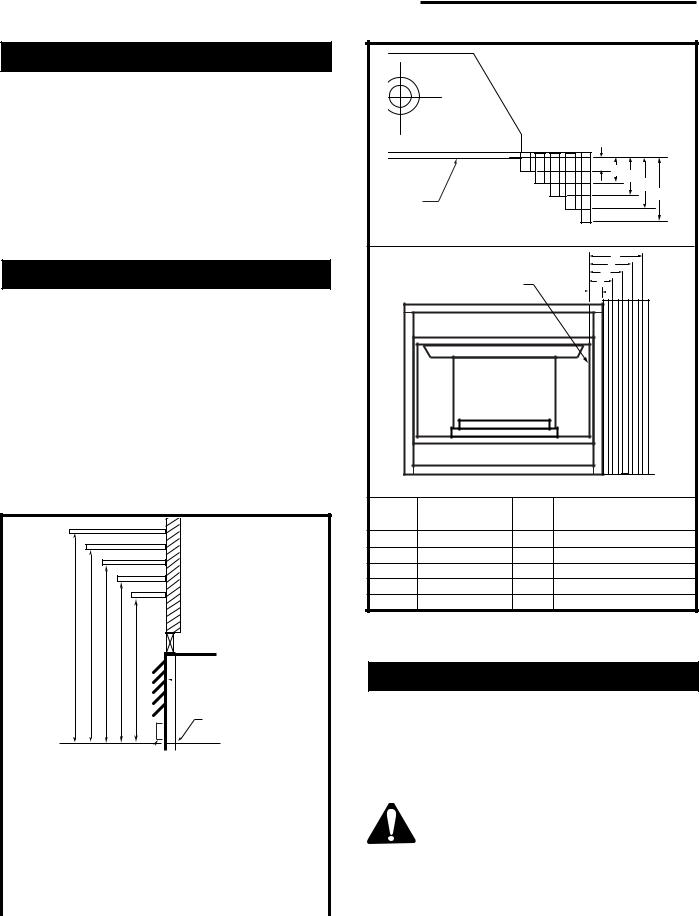
Vermont Castings, Majestic Products DVRT36/39/43
Clearance to Combustibles
Appliance |
|
Top ............................................................ |
0” (0mm) |
Bottom ....................................................... |
0” (0mm) |
Side ........................................................... |
0” (0mm) |
Back .......................................................... |
0” (0mm) |
Venting |
|
Concentric sections of DV Vent ................... |
1” (25mm) |
Non-concentric sections of DV Vent |
|
Sides and bottom .................................... |
1” (25mm) |
Top .......................................................... |
2” (51mm) |
Mantels
The height a combustible mantel is fitted above the fireplace is dependent on the depth of the mantel. This also applies to the distance between the mantel leg (if fitted) and the fireplace.
Refer to Figures 4a and 4b and the Mantel Charts below them for correct mounting heights and widths.
•The distances and reference points are not affected by the fitting of a bay window front trim kit.
•Noncombustible mantels and legs may be installed at any height and width around the appliance.
•When using paint or lacquer to finish the mantel, it must be heat-resistant to prevent discoloration.
V
W
X
Y
Z
A B C D E
Fireplace
Fireplace
 Louvre Assembly
Louvre Assembly
Top
Top of Combustion
Chamber
Bottom of Door Trim 
CFM146
Mantel Chart
|
Mantel Shelf |
|
Mantel from Top |
Ref. |
or Breast Plate |
Ref. |
of Comb. Chamber |
|
Depth |
|
|
V |
10” (254mm) |
A |
19” (483mm) |
W |
8” (203mm) |
B |
17” (432mm) |
X |
6” (152mm) |
C |
15” (381mm) |
Y |
4” (101mm) |
D |
13” (330mm) |
Z |
2” (51mm) |
E |
11” (279mm) |
Fig. 4a Combustible mantel leg minimum installation.
|
|
|
J |
I H |
Black |
|
|
|
|
Surround |
|
|
G |
|
|
|
F |
||
Face |
|
Mantel |
|
|
|
|
Leg |
|
|
|
Mantel |
|
|
|
|
Leg |
|
|
|
|
|
|
|
CFM164a |
|
|
|
|
K |
Side of |
|
M |
L |
|
|
|
|||
Combustion Chamber |
N |
|
||
|
|
|
O |
|
|
|
|
|
CFM170 |
|
Mantel |
|
Mantel Leg from Side |
|
Ref. |
Leg Depth |
Ref. |
of Comb. Opening |
|
F |
10” (254mm) |
K |
11¹⁄ ” (292mm) |
|
G |
8” (203mm) |
L |
9¹⁄ ” (241mm) |
|
H |
6” (152mm) |
M |
7¹⁄ ” (191mm) |
|
I |
4” (101mm) |
N |
5¹⁄ ” (140mm) |
|
J |
2” (51mm) |
O |
3¹⁄ ” (89mm) |
|
Fig. 4b Combustible mantel leg minimum installation.
Hearth
Although a hearth is not mandatory, one is recommended for aesthetic purposes. A noncombustible hearth which projects out 12” (305mm) or more from the front of the fireplace is recommended.
Cold Climate Installation Recommendation:
When installing this unit against a noninsulated exterior wall or chase, it is mandatory that the outer walls be insulated to conform to applicable insulation codes.
6 |
10002428 |
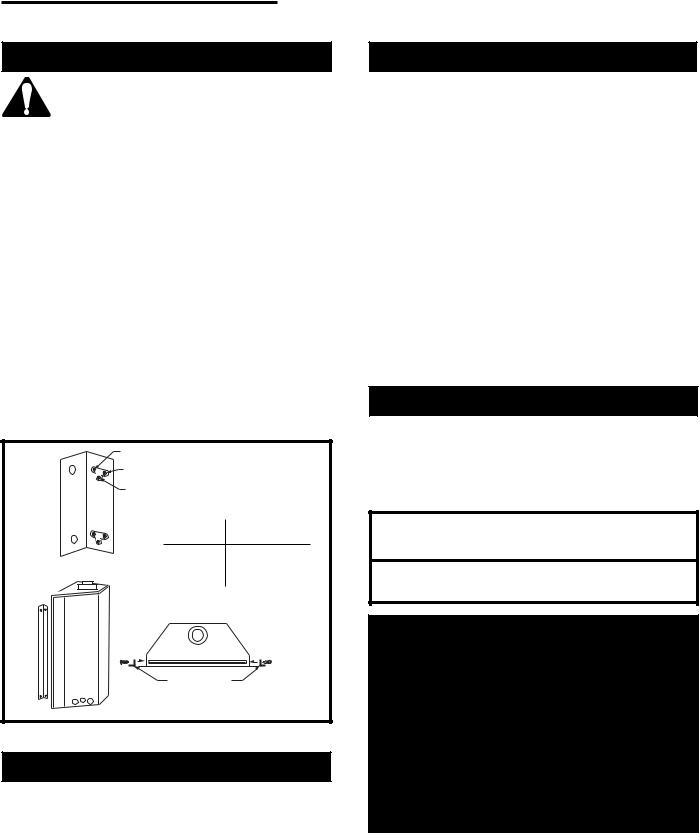
Vermont Castings, Majestic Products DVRT36/39/43
Framing & Finishing
Check the fireplace to make sure it is leveled and properly positioned.
1.Choose the unit location.
2.Place the unit into position and secure it to the floor with 1¹⁄” (38mm) screws or nails. Holes for securing the unit to floor are located behind the access door grille on the left and right sides of the unit.
3.Frame in the fireplace with a header across the top. It is important to allow for the finished wall face when setting the depth of the frame.
4.Attach the fireplace to the frame using the adjustable frame drywall strips (located behind the access door for shipping). Preset the depth to suit the facing material of the wall. The strips are adjustable to 1/2” (13mm), 5/8” (16mm) or
3/4” (19mm). (Fig. 5)
5.Screw through the slotted holes in the drywall strip and into predrilled holes in fireplace side. Measure from face of fireplace to the face of the drywall strip to confirm the final depth.
|
C |
Adjustable Drywall Strip |
|
|
A |
||
|
(Nailing Flange) |
||
|
|
||
|
B |
|
|
|
|
Screw |
Drywall |
|
|
Position |
Depths |
|
|
A |
1/2” (13mm) |
|
|
B |
5/8” (16mm) |
|
|
C |
3/4” (19mm) |
|
|
Adjustable |
|
|
|
1/2” – 5/8” – 3/4” |
|
|
|
Spacing |
|
|
|
|
FP1023 |
Fig. 5 |
Adjustable drywall strip (nailing flanges). |
||
Final Finishing
Noncombustible materials such as brick or tile may be extended over the edges of the face of the appliance.
DO NOT cover the window frame assembly, any vent, louvre assembly top or louvre assembly bottom.
If a Trim Kit is to be installed on the fireplace, the brick or tile will have to be installed flush with the edges of the appliance.
Gas Specifications
|
|
|
Max. |
Min. |
|
|
|
Input |
Input |
Model |
Fuel |
Gas Control |
BTU/h |
BTU/h |
DVRT36RN |
Nat |
Millivolt |
25,000 |
17,500 |
DVRT36RP |
Prop |
Millivolt |
25,000 |
18,750 |
DVRT36EN |
Nat |
24V Hi/Lo |
25,000 |
17,500 |
DVRT36EP |
Prop |
24V Hi/Lo |
25,000 |
18,750 |
DVRT36RFN |
Nat |
Comfort Control |
25,000 |
17,500 |
DVRT36RFP |
Prop |
Comfort Control |
25,000 |
18,750 |
DVRT36RMH |
Nat/ Prop |
Millivolt |
25,000 |
17,500 |
DVRT39RN |
Nat |
Millivolt |
30,000 |
21,000 |
DVRT39RP |
Prop |
Millivolt |
30,000 |
22,500 |
DVRT39EN |
Nat |
24V Hi/Lo |
30,000 |
21,000 |
DVRT39EP |
Prop |
24V Hi/Lo |
30,000 |
22,500 |
DVRT43RN |
Nat |
Millivolt |
33,000 |
23,100 |
DVRT43RP |
Prop |
Millivolt |
33,000 |
24,750 |
DVRT43EN |
Nat |
24V Hi/Lo |
33,000 |
23,100 |
DVRT43EP |
Prop |
24V Hi/Lo |
33,000 |
24,750 |
Gas Inlet and Manifold Pressures
|
Natural |
LP (Propane) |
Inlet Minimum |
5.5” w.c. |
11.0” w.c. |
Inlet Maximum |
14.0” w.c. |
14.0” w.c. |
Manifold Pressure |
3.5” w.c. |
10.0” w.c. |
|
|
|
DVRT36/ DVRT36RMH/ DVRT39/ DVRT43
Certified To
ANSI Z21.88-2002/ CSA 2.33-2002
Vented Gas Fireplace Heaters
High Elevations
Input ratings are shown in BTU per hour (BTU/h) and are certified without deration for elevations up to 4,500 feet (1,370 m) above sea level.
For elevations above 4,500 feet (1,370 m) in USA, installations must be in accordance with the current ANSI Z223.1/NFPA 54 and/or local codes having jurisdiction.
In Canada, please consult provincial and/or local authorities having jurisdiction for installations at elevations above 4,500 feet (1,370 m).
10002428 |
7 |
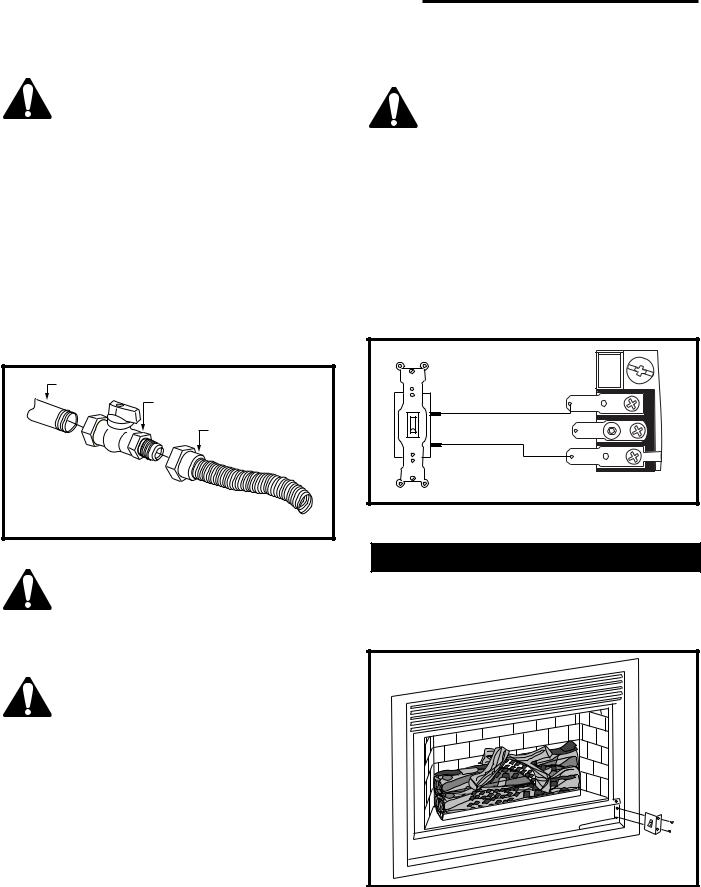
Vermont Castings, Majestic Products DVRT36/39/43
Gas Line Installation |
|
Remote ON/ OFF Switch Installation |
|
|
|
When purging the gas lines, the front glass must be removed.
The gas pipeline can be brought in through the side of the fireplace as well as the bottom. Knockouts are provided on the bottom behind the valve to allow for the gas pipe installation and testing of any gas connection. It is most convenient to bring the gas line in from the rear right side of the valve as this allows fan installation or removal without disconnecting the gas line.
The gas line connection can be made with properly tinned 3/8” copper tubing, 3/8” rigid pipe or an approved flex connector. Since some municipalities have additional local codes, it is always best to consult your local authority and the CSA-B149.1 installation codes.
For USA installations consult the current National Fuel Gas Code, ANSI Z223.1/NFPA 54.
1/2” Gas Supply
1/2” NPT x 1/2” Flare
Shut-Off Valve
3/8” Flex Line
(From Valve)
FP297A
Fig. 6 Typical gas supply installation.
Always check for gas leaks with a mild soap and water solution applied with a brush no larger than 1” (25 mm). Never apply soap and water solution with a spray bottle. Do not use an open flame for leak testing.
The fireplace valve must not be subjected to any test pressures exceeding 1/2 p.s.i. Isolate or disconnect this or any other gas appliance control from the gas line when pressure testing.
The gas control is equipped with a captured screw type pressure test point; therefore, it is not necessary to provide a 1/8” test point upstream of the control.
When using copper or flex connector use only approved fittings. Always provide a union when using black iron pipe so that the gas line can be easily disconnected for burner or fan servicing. (Fig. 6) See the gas specifications for pressure details and ratings.
Do not wire the remote ON/OFF wall switch for this gas appliance into a 120 V power supply.
1.Thread the wiring through the electrical knockout located on either side of the unit. Take care not to cut the wire or insulation on metal edges. Ensure the wire is secured and protected from possible damage. Run one end to the gas control valve and the other end to the conveniently located wall switch.
2.Attach the wire to the ON/ OFF switch and install the switch into the receptacle box. Attach the cover plate to the switch.
3.Connect the wire to the gas control valve. (Fig. 7)
|
Remote |
|
ON/OFF |
|
Switch |
|
TPTH |
|
TP |
|
TH |
|
W584-9 |
Fig. 7 |
Remote switch wiring diagram for R models. |
Alternate Switch Location
The remote switch can be installed on either side of the access door. Mount the switch to the bracket provided and screw the bracket to either side of the frame, using the pre-punched holes. (Fig. 8)
CFM104 |
Fig. 8 Alternate switch location.
8 |
10002428 |
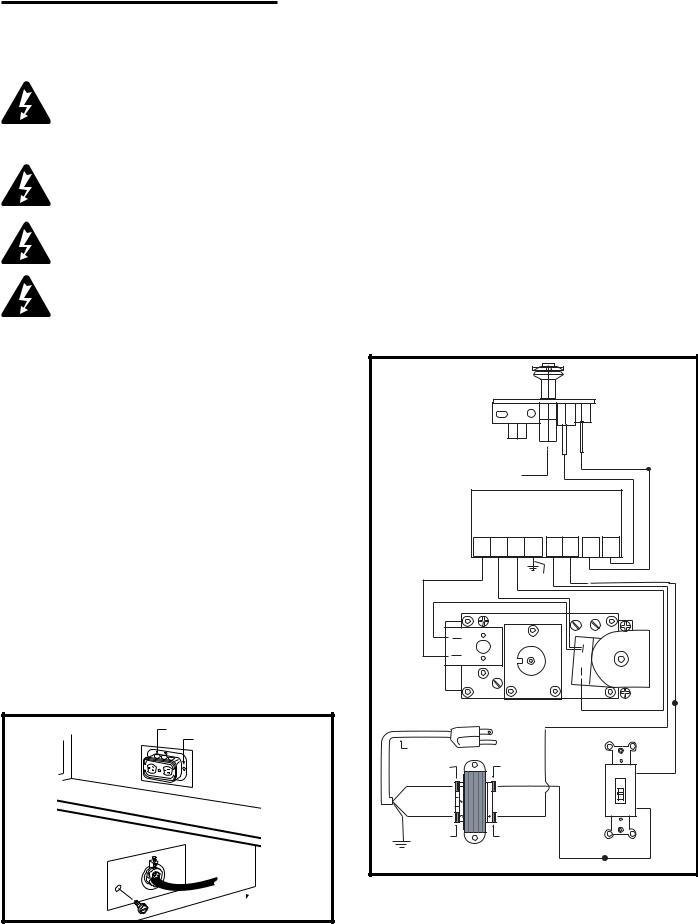
Vermont Castings, Majestic Products DVRT36/39/43
EB-1 Electrical Box |
|
Electronic Gas Control Valve |
|
|
|
The fireplace, when installed, must be electrically connected and grounded in accordance with local codes; or, in the absence of local codes, with the current CSA C22.1 Canadian Electrical Code
For USA installations, follow the local codes and the national electrical code ANSI/NFPA No. 70.
It is strongly suggested that a licensed electrician perform the wiring of the EB-1 Electrical Junction Box.
Ensure that the power to the supply line has been disconnected before commencing this procedure.
The EB-1 Electrical junction box is fitted with this model to provide for easy installation of an optional fan kit.
To connect the EB-1 box to the house electrical supply follow the steps below:
1.Unscrew the retaining screw from the EB-1 base plate (Fig. 9), and remove the EB-1 assembly from the fireplace.
2.Remove the front cover of the EB-1 box.
3Remove the plug socket assembly from the EB-1 box.
4.Feed the supply line in from the outside through the cable clamp. (Fig. 9)
5.Connect black wire of the power supply line to the brass screw (polarized) of the socket assembly.
6.Connect the white wire of the power line to the chrome screw of the socket assembly.
7.Connect the ground wire of the supply line to the green screw of the socket assembly.
8.Refit the socket assembly back into the electrical box and replace the cover plate. Secure the cable with the clamp on the outside of the unit to prevent strain on the connections.
Inside |
Electrical Box |
|
Retaining Screw |
 Front of Unit
Front of Unit
Outside
Front |
of |
Unit |
|
FP580 |
|
|
|
Fig. 9 EB-1 receptacle.
This appliance may be fitted with a Honeywell ignition module.
Installation of the remote on/off starter switch on electronic ignition units:
1.Thread the wiring through the holes on the side panels of the appliance. Take care not to cut the wire or insulation on metal edges. Route the wire to a conveniently located receptacle box.
2.Attach the wire to the ON/OFF switch and install the switch into the receptacle box. (Fig. 10)
3.Connect the White wire from the wall switch to the Black wire from the transformer, using an approved wire nut. Connect the Black wire from the wall switch to the Black wire running from the #6 position of the ignition module, also using an approved wire nut.
|
PILOT |
|
|
|
|
|
|
|
HONEYWELL IGNITION MODULE |
|
|||
|
|
|
24V |
|
|
|
MV |
MV/VP |
PV |
GRD |
24V |
SENSE |
SPARK |
1 |
2 |
3 |
5 |
6 |
8 |
9 |
|
|
|
GREEN |
|
|
BLACK |
RED |
|
|
|
|
|
|
|
|
|
|
|
|
|
ORANGE |
ORANGE |
|
|
|
|
|
|
|
|
|
|
|
|
|
|
LO |
|
|
|
|
|
|
HI |
|
|
|
|
|
|
NOVA SIT 822 VALVE |
|
|
BLUE |
|
WHITE |
|
|
|
|
|
|
POWER CORD |
|
|
|
|
|
|
W/FEMALE SPADE |
|
|
|
|
|
|
120 VAC RTN |
24 VAC HOT |
|
|
|
BLACK |
|
|
|
|
|
|
|
|
WHITE |
|
BLACK |
|
|
|
OFF |
|
|
|
|
|
|
WHITE |
BLACK |
|
YELLOW |
|
|
|
|
GREEN |
|
|
|
|
|
|
120 VAC HOT |
24 VAC RET |
|
|
|
|
|
40VA TRANSFORMER |
|
|
|
|
WALL SWITCH |
|
|
|
|
|
|
||
|
|
|
|
BLACK |
WHITE |
|
|
|
|
|
|
|
FP1225 |
Fig. 10 Honeywell ignition module.
10002428 |
9 |
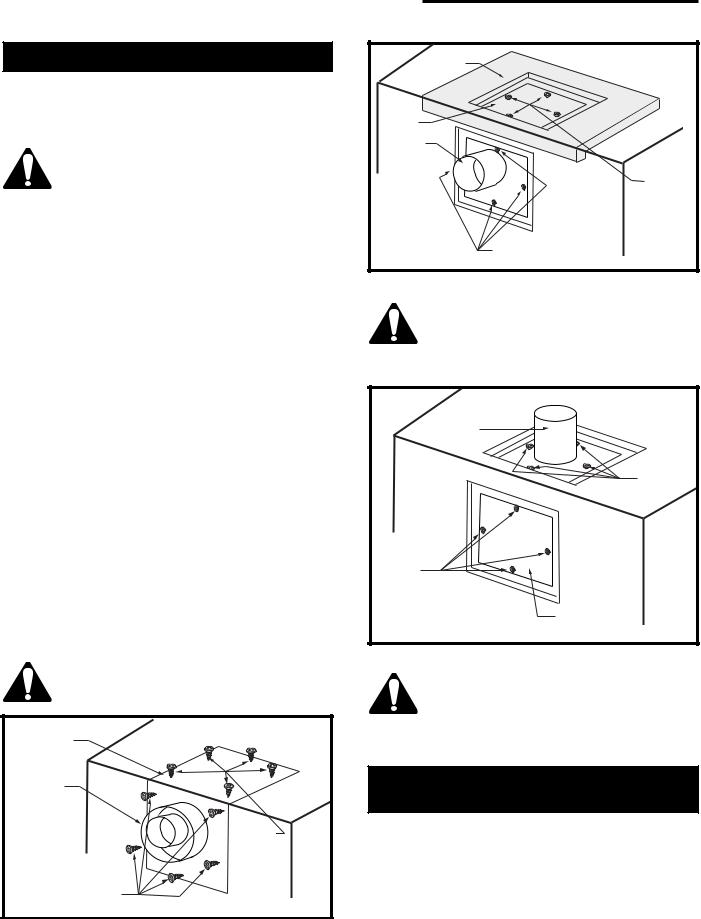
Vermont Castings, Majestic Products DVRT36/39/43
Optional Top Vent Application
The DVRT appliance is shipped as a rear vent unit. If the installation layout requires the unit to be a top vent configuration the appliance can be converted by following the steps below.
When removing and refitting the plates and adapter, be sure the associated gaskets are undamaged and refitted as required.
1.Remove the ten (10) screws securing the outer collar adapter to the fireplace body. (Fig. 11)
2.Set the collar aside, complete with the gasket.
Do not damage the gasket, as the adapter and gasket must be refitted.
3.Remove the insulation material (exposed in Step 2) from the top of the unit. (Fig. 12) This material can be discarded. However, if the unit is converted back to rear vent for any reason a new piece of insulation material approved by Vermont Castings, Majestic Products must be used for this purpose.
4.Remove the four (4) screws securing the flue cover plate to the top of the intake box and remove the cover and gasket. (Fig. 12)
5.Remove the four (4) screws securing the flue pipe to the back of the intake box and remove the pipe and gasket. (Fig. 12)
6.Secure the plate and gasket removed in Step 4 over the flue opening in the back of the intake box. Ensure the gasket is in place and undamaged.
7.Install the flue pipe and gasket removed in Step 5 over the flue opening in the top of the intake box. (Fig. 13)
8.Refit the outer collar adapter and gasket to the unit with the round collar on the top. Secure the adapter with the ten (10) screws removed in Step 1.
|
Insulation |
Flue |
|
Cover |
|
Flue |
|
Pipe |
|
|
Remove |
|
Screws |
|
(4) |
|
Remove Screws (4) |
|
FP1027 |
Fig. 12 |
Remove flue cover, flue pipe and insulation pad. |
The insulation pad extends beyond the opening in the top of the unit. Be sure to remove all of the insulation material before completing the conversion.
|
Flue Pipe |
|
Replace |
|
Screws |
|
(4) |
Replace |
|
Screws |
|
(4) |
|
|
Flue Cover |
|
FP1028 |
Fig. 13 |
Flue cover and flue pipe location. |
When converting appliance to top vent, ensure the insulation material referred to in Step 3 is completely removed.
Outer Collar |
Rear View |
Adapter |
|
Flue
Pipe
Remove
Screws
(5)
Remove
Screws (5)
FP1030
After conversion to top vent configuration, the 4” (102mm) flue pipe should be concentric within the 7” (175mm) outer collar.
Installing the DVRT36RMH
in a Mobile Home
NOTE: Refer to “For Use in Mobile Homes: Model DVRT36RMH” on Pages 46 and 47.
Fig. 11 Remove screws from outer collar adapter.
10 |
10002428 |

Vermont Castings, Majestic Products DVRT36/39/43
General Venting
Your fireplace is approved to be vented either through the side wall, or vertically through the roof.
NOTE: Only venting components specifically approved and labeled for this fireplace may be used.
•Venting terminals shall not be recessed into a wall or siding.
•Horizontal venting must be installed on a level plane without any incline or decline.
•There must not be any obstructions such as bushes, garden sheds, fences, decks, or utility buildings within 24” (610mm) from the front of the termination hood.
•Do not locate the termination hood where excessive snow or ice buildup may occur.
•Be sure to check and clear the vent termination area after snow falls, to prevent accidental blockage of venting system.
•When using snow blowers, make sure snow is not directed toward the vent termination area.
Location of Vent Termination
It is imperative to observe minimum clearances (shown on the following page) when locating vent terminations.
10002428 |
11 |
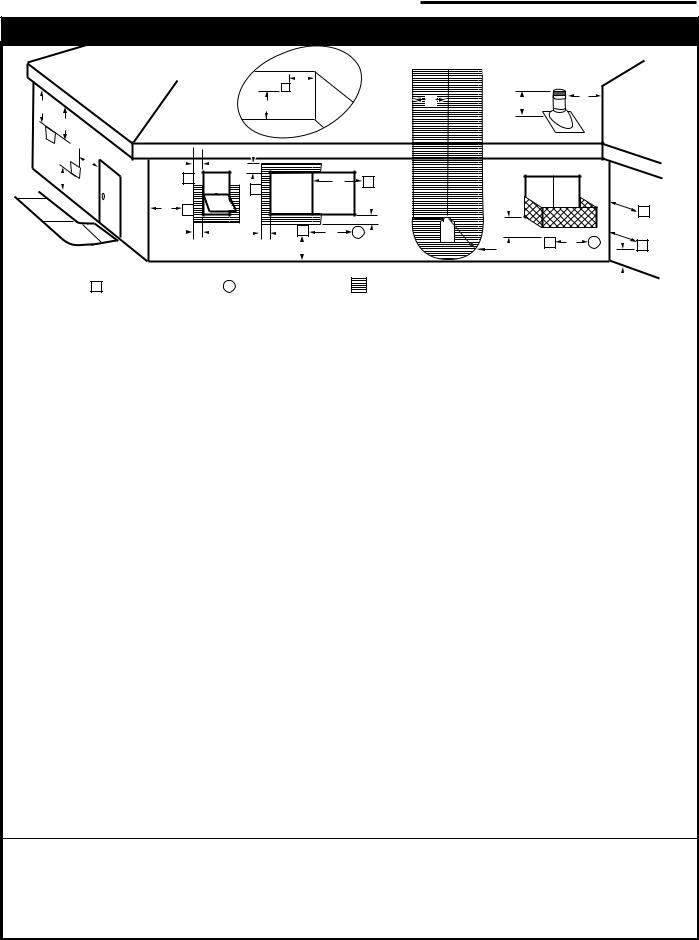
Vermont Castings, Majestic Products DVRT36/39/43
General Venting Information - Termination Location
|
|
INSIDE |
|
|
|
|
CORNER DETAIL |
|
|
|
|
G |
|
|
|
|
V |
N |
|
|
|
H |
||
D |
A |
N |
||
|
||||
|
E |
|
|
|
|
V |
|
|
V
L
B
|
|
C |
|
V |
Fixed |
|
|
Closed |
F |
V |
Operable |
|
||
|
|
B |
B |
|
|
|
|
|
|
|
|
V |
|
B |
V |
|
|
|
|
|
Operable |
Fixed |
|
|
|
|
G |
||
|
Closed |
|
|
|
|
|||
|
|
|
|
|
|
|||
|
|
|
B |
|
|
|
V |
|
|
V J |
M |
|
|
G |
|||
B |
X |
|
|
|||||
V |
K |
X |
||||||
|
A |
|
I |
V |
||||
|
|
|
|
|
|
|||
A
V VENT TERMINATION X AIR SUPPLY INLET |
AREA WHERE TERMINAL IS NOT PERMITTED |
CFM145a
|
|
|
Canadian Installations1 |
US Installations2 |
|
|
A = Clearance above grade, veranda, porch, |
12” (30cm) |
12” (30cm) |
||
|
|
deck, or balcony |
|
|
|
|
B = Clearance to window or door that may be |
6” (15cm) for appliances |
6” (15cm) for appliances |
||
|
|
opened |
< 10,000Btuh (3kW), 12” (30cm) |
< 10,000 Btuh (3kW), 9” |
|
|
|
|
for appliances > 10,000 Btuh (3kW) and |
(23cm) for appliances > 10,000 |
|
|
|
|
< 100,000 Btuh (30kW), 36” (91cm) |
Btuh (3kW) and < 50,000 Btuh |
|
|
|
|
for appliances > 100,000 Btuh (30kW) |
(15kW), 12” (30cm) for |
|
|
|
|
|
appliances > 50,000 Btuh (15kW) |
|
|
C = Clearance to permanently closed window |
12” (305mm) recommended to |
12” (305mm) recommended to |
||
|
|
|
prevent window condensation |
prevent window condensation |
|
|
D = Vertical clearance to ventilated soffit located |
|
|
|
|
|
|
above the terminal within a horizontal |
18” (458mm) |
18” (458mm) |
|
|
|
distance of 2 feet (610mm) from the center |
|
|
|
|
|
line of the terminal |
|
|
|
|
E = Clearance to unventilated soffit |
12” (305mm) |
12” (305mm) |
||
|
F = |
Clearance to outside corner |
see next page |
see next page |
|
|
G = Clearance to inside corner (see next page) |
see next page |
see next page |
||
|
H = Clearance to each inside of center line |
3’ (91cm) within a height of 15’ |
3’ (91cm) within a height of 15’ |
||
|
|
extended above meter/regulator assembly |
above the meter/regulator assembly |
above the meter/regulator assy |
|
|
I = |
Clearance to service regulator vent outlet |
3’ (91cm) |
3’ (91cm) |
|
|
J = |
Clearance to nonmechanical air supply inlet |
6” (15cm) for appliances < 10,000 |
6” (15cm) for appliances |
|
|
|
to building or the combustion air inlet to any |
Btuh (3kW), 12” (30cm) for |
< 10,000 Btuh (3kW), 9” |
|
|
|
other appliances |
appliances > 10,000 Btuh (3kW) and < |
(23cm) for appliances > 10,000 |
|
|
|
|
100,000 Btuh (30kW), 36” (91cm) |
Btuh (3kW) and < 50,000 Btuh |
|
|
|
|
for appliances > 100,000 Btuh (30kW) |
(15kW), 12” (30cm) for |
|
|
|
|
|
appliances > 50,000 Btuh (15kW) |
|
|
K = Clearance to a mechanical air supply inlet |
6’ (1.83m) |
3’ (91cm) above if within 10’ |
||
|
|
|
|
(3m) horizontally |
|
|
L = |
Clearance above paved sidewalk or paved |
7’ (2.13m)† |
7’ (2.13m)† |
|
|
|
driveway located on public property |
|
|
|
|
M = Clearance under veranda, porch, deck or |
12” (30cm)‡ |
12” (30cm)‡ |
||
|
|
balcony |
|
|
|
N = Clearance above a roof shall extend a minimum of 24” (610mm) above the highest point when it passes through the roof surface, and any other obstruction within a horizontal distance of 18” (450mm).
1In accordance with the current CSA-B149 Installation Codes
2In accordance with the current ANSI Z223.1/NFPA 54 National Fuel Gas Codes
† A vent shall not terminate directly above a sidewalk or paved driveway which is located between two single family dwellings a nd serves both dwellings
‡ only permitted if veranda, porch, deck or balcony is fully open on a minimum 2 sides beneath the floor: NOTE: 1. Local codes or regulations may require different clearances.
2. The special venting system used on Vermont Castings, Majestic Products Direct Vent Fireplaces are certified as part of the appliance, with clearances tested and approved by the listing agency.
Fig. 14 Vent termination clearances.
12 |
10002428 |

Vermont Castings, Majestic Products DVRT36/39/43
Termination Clearances
Termination clearances for buildings with combustible and noncombustible exteriors.
Inside Corner Outside Corner Recessed Location
|
|
|
|
|
|
|
|
|
|
|
B = |
C |
|
|
|
|
D |
|
|
|
|
C |
||
|
|
|
|
|
|
|
|
|
|
|
|
|
|
|
|
|
|
|||||||
|
|
|
|
|
|
|
|
|
|
|
|
|
|
|
|
|
|
|
|
|
||||
|
|
|
|
|
|
|
A = |
|
|
|
Combustible |
|
|
|
|
|
|
|
|
|
|
|||
A |
|
|
|
|
Combustible |
|
|
|
6" (152 mm) |
|
|
|
|
|
|
|
E |
|
|
|||||
|
|
|
|
|
|
|
|
|
|
|
|
|
|
|||||||||||
|
|
|
|
|
|
|
Noncombustible |
|
|
|
|
|
|
|
|
|
|
|
|
|
||||
|
|
|
|
|
|
|
6" (152 mm) |
|
V |
|
|
|
|
|
V |
|
|
|
|
|
||||
|
|
|
|
|
|
|
|
|
|
|
|
|
|
|
|
|
|
|||||||
|
|
|
|
|
|
|
Noncombustible |
|
2" (51 mm) |
|
|
|
|
|
|
|||||||||
|
|
|
V |
|
|
|
|
|
|
|
|
|
|
|
|
|
|
|
|
|
|
|||
|
|
|
|
|
|
|
B |
|
|
|
|
|
|
|
|
|
|
|
|
|
||||
|
|
|
|
2" (51 mm) |
|
|
|
|
|
|
|
|
|
|
|
|
|
|
|
|
||||
|
|
|
|
|
|
|
|
|
|
|
|
|
|
|
|
|
|
|
|
|
|
|
|
|
Balcony |
Balcony |
|
|
with no side wall |
with perpendicular side wall |
|
|
|
H |
C = Maximum depth of 48" |
|
G |
(1219mm) for recessed |
||
|
location. |
||
V |
V |
D = Minimum width for back wall |
|
|
|
of a recessed location. |
|
|
J |
Combustible 38" (965 mm) |
|
G = |
Combustible & |
Noncombustible 24" (610 mm) |
|
Noncombustible |
|
||
Combustible |
E = Clearance from corner in |
||
|
|||
Noncombustible |
H = 24" (610 mm) |
recessed location. |
|
12" (305 mm) |
J = 20" (508 mm) |
Combustible 6" (152 mm) |
|
|
Noncombustible 2" (50 mm) |
CFM115
Fig. 15 Termination clearances.
General Information for Connecting Vent Pipes
Crimped End Pipes
Before joining elbows and pipes, apply a bead of high temperature sealant to the crimped end of the elbow or pipe.
Join the pipes using a 2” (51mm) overlap and secure the joints with three (3) sheet metal screws. (Fig. 16) Wipe off excess sealant.
Canadian Installations:
The venting system must be installed in accordance with the current CSA-B149.1 installation code.
USA Installations:
The venting system must conform to local codes and/ or the current National Fuel Code ANSI Z223.1/NFPA 54.
1" (25 mm) from  crimped end of pipe
crimped end of pipe
Screw
Holes
CFM175
Fig. 16 Apply a bead of high temperature sealant.
Only venting components manufactured by Vermont Castings, Majestic Products may be used in Direct Vent systems.
10002428 |
13 |
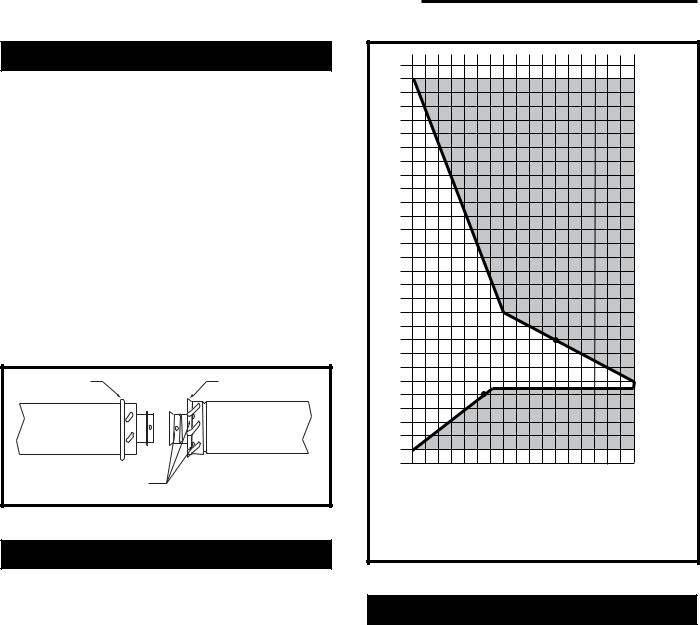
Vermont Castings, Majestic Products DVRT36/39/43
Twist-lock Pipes
When using Vermont Castings, Majestic Products twist-lock pipe it is not necessary to use sealant on the joints. The only areas of the venting system that need to be sealed with high temperature silicone sealant are the collars on the fireplace and the sliding joint of any telescopic vent section used in the system.
To join twist-lock pipes together, simply align the beads of the male end with the grooves of the female end, twisting the pipe until the flange on the female end contacts external flange on the male end. It is recommended that you secure the joints with three (3) sheet metal screws; however, this is not mandatory with twist-lock pipe. (Fig. 17)
To make it easier to assemble the joints we suggest putting a lubricant (Vaseline or similar) on the male end of the twist-lock pipe prior to assembly.
|
Male End |
Female End |
|
Screw Holes |
|
|
|
TWL100 |
Fig. 17 |
Twist-lock pipe joints. |
|
How to Use the Vent Graph
The Vent Graph should be read in conjunction with the following vent installation instructions to determine the relationship between the vertical and horizontal dimensions of the vent system.
1.Determine the height of the center of the horizontal vent pipe exiting through the outer wall. Using this dimension on the Sidewall Vent Graph below, locate the point intersecting with the slanted graph line.
2.From the point of this intersection, draw a vertical line to the bottom of the graph.
3.Select the indicated dimension, and position the fireplace in accordance with same.
Example A:
If the vertical dimension from the floor of the fireplace is 11’ (3.4m), the horizontal run to the face of the outer wall must not exceed 14’ (4.3m).
Example B:
If the vertical dimension from the floor of the unit is 7’ (2.14m), the horizontal run to the face of the outer wall must not exceed 8¹⁄’ (2.6m).
30 |
|
|
|
|
|
|
|
|
|
|
|
|
29 |
|
|
|
|
|
|
|
|
|
|
|
|
28 |
|
|
|
|
|
|
|
|
|
|
|
|
27 |
|
|
|
|
|
|
|
|
|
|
|
|
26 |
|
|
|
|
|
|
|
|
|
|
theto |
Vertical |
25 |
|
|
|
|
|
|
|
|
|
|
||
|
|
|
|
|
|
|
|
|
|
|
|
|
24 |
|
|
|
|
|
|
|
|
|
|
|
|
23 |
|
|
|
|
|
|
|
|
|
|
centerhorizontalventpipetheof |
dimensionfromfloorunitthetheof |
22 |
|
|
|
|
|
|
|
|
|
|
||
|
|
|
|
|
|
|
|
|
|
|
|
|
21 |
|
|
|
|
|
|
|
|
|
|
|
|
20 |
|
|
|
|
|
|
|
|
|
|
|
|
19 |
|
|
|
|
|
|
|
|
|
|
|
|
18 |
|
|
|
|
|
|
|
|
|
|
|
|
17 |
|
|
|
|
|
|
|
|
|
|
|
|
16 |
|
|
|
|
|
|
|
|
|
|
|
|
15 |
|
|
|
|
|
|
|
|
|
|
|
|
14 |
|
|
|
|
|
|
|
|
|
|
|
|
13 |
|
|
|
|
|
|
|
|
|
|
|
|
|
|
|
|
|
|
|
|
|
|
|
|
|
12 |
|
|
|
|
|
|
|
|
eg: A |
|
|
|
11 |
|
|
|
|
|
|
|
|
|
|
|
|
|
|
|
|
|
|
|
|
|
|
|
|
|
10 |
|
|
|
|
|
|
|
|
|
|
|
|
9 |
|
|
|
|
|
|
|
|
|
|
|
|
8 |
|
|
|
|
|
|
|
|
|
|
|
|
7 |
|
|
|
|
|
|
|
|
|
|
|
|
|
|
|
|
|
|
eg: B |
|
|
|
|
|
|
6 |
|
|
|
|
|
|
|
|
|
|||
|
|
|
|
|
|
|
|
|
|
|
|
|
|
|
|
|
|
|
|
|
|
|
|
|
|
5 |
|
|
|
|
|
|
|
|
|
|
|
|
4 |
|
|
|
|
|
|
|
|
|
|
|
|
3 |
|
|
|
|
|
|
|
|
|
|
|
|
3 |
4 |
5 |
6 |
7 |
8 |
9 |
10 11 12 13 14 15 16 17 18 19 |
20 |
|
|||
Horizontal dimension from the outside face of the wall to the center of the fireplace vent flange
Sidewall Vent Graph showing the relationship between vertical and horizontal dimensions for a Direct Vent flue system.
CFM102
Fig. 18 Sidewall Vent Graph (dimensions in ft.).
Rear Wall Vent Application
When installed as a rear vent unit this appliance may be vented directly to a termination located on the rear wall behind the appliance.
•Only Vermont Castings, Majestic Products venting components are approved to be used in these applications. See ‘Venting Components’ listed for different installation requirements.
•The maximum horizontal distance between the rear of the appliance (or end of the transition elbow in a corner application) and the outside face of the rear wall is 20” (508 mm). (Fig. 19)
•Only one 45° elbow is allowed in these installations.
•The minimum clearances between any combustible
material and the vent pipe sections are:
Top |
2” (51mm) |
Sides |
1” (25mm) |
Bottom |
1” (25mm) |
14 |
10002428 |
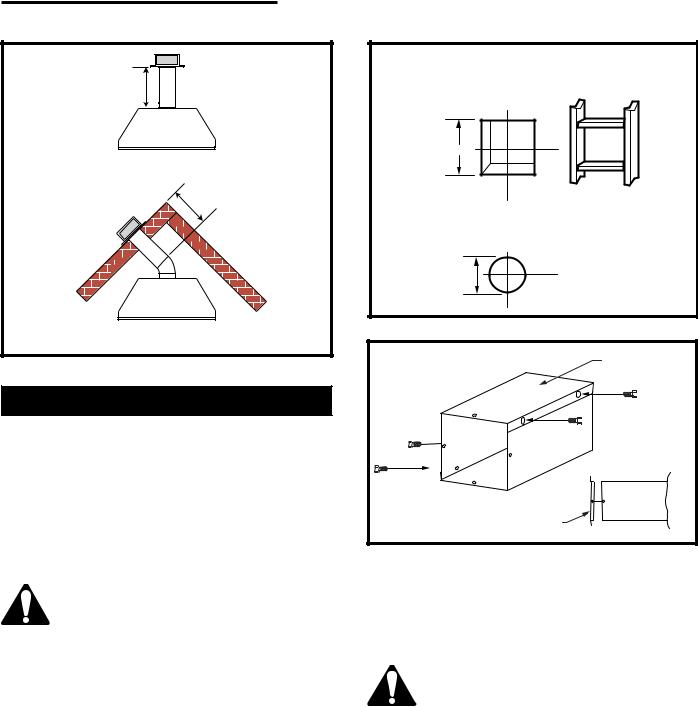
Vermont Castings, Majestic Products DVRT36/39/43
Max. 20"
(508 mm)
Top view flat installation
Max. 20" |
(508 mm) |
Top view corner installation
FP1188
Fig. 19 Rear vent application, maximum horizontal distance.
Rear Wall Vent Installation
Step 1
Locate and cut the vent opening in the wall.
For combustible walls, first frame in opening. (Fig. 20)
Combustible Walls: Cut a 10³⁄ ” H x 9³⁄ ” W (265 x 240mm) hole through the exterior wall and frame as shown.
Noncombustible Walls: Hole opening should be 7¹⁄ ” (190mm) in diameter.
Zero clearance sleeve is required only for combustible walls.
Step 2
Measure wall thickness and cut zero clearance sleeve parts to proper length (maximum 12” / 305mm). Assemble sleeve to its maximum opening (10³⁄ ” x 9³⁄ ”)(265 x 240mm), and attach to firestop with #8 sheet metal screws (supplied). Install firestop assembly. (Fig. 21)
Step 3
Measure the horizontal length requirement for the venting including a 2” (51mm) overlap; i.e., from the elbow to the outside wall face plus 2” (51mm).
(Fig. 19)
Step 4
Install the 4” (102mm) vent to the appliance collar and secure with 3 sheet metal screws. Install the 7” (175mm) vent pipe to the appliance collar and secure with 3 sheet metal screws. If a 45° elbow is being
Vent Opening — Combustible Wall
(240mm)  9³⁄ "
9³⁄ "

10³⁄ " (254mm)
(framing detail)
Vent Opening — Noncombustible Wall
|
7¹⁄ " |
|
(190mm) |
|
CFM116 |
Fig. 20 |
Vent opening, side wall. |
|
Maximum Length |
|
12” (305mm) |
|
#8 Screws (2) |
#8 Screws (2) |
|
|
Side View |
|
Firestop |
|
CFM135a |
Fig. 21 Adjustable zero clearance sleeve |
|
used, attach the elbow to the appliance with sealant in the same manner then attach the venting to the elbow. It is not necessary to seal the 45° elbow to the starter pipe or termination in the straight out and 45° installation in Figure 19.
It is critical that there is no downward slope away from the appliance when connecting the vent or elbow.
Step 5
Guide the venting through the vent hole as you place the appliance in its installed position. Guide the 4” (102mm) and 7” (175mm) collars of the vent termination into the outer ends of the venting. Do not force the termination. If the vent pipes do not align with the termination, remove and realign the venting at the appliance flue collars. (Fig. 22) Attach the termination to the wall as outlined in the instruction sheet supplied with the termination.
10002428 |
15 |
